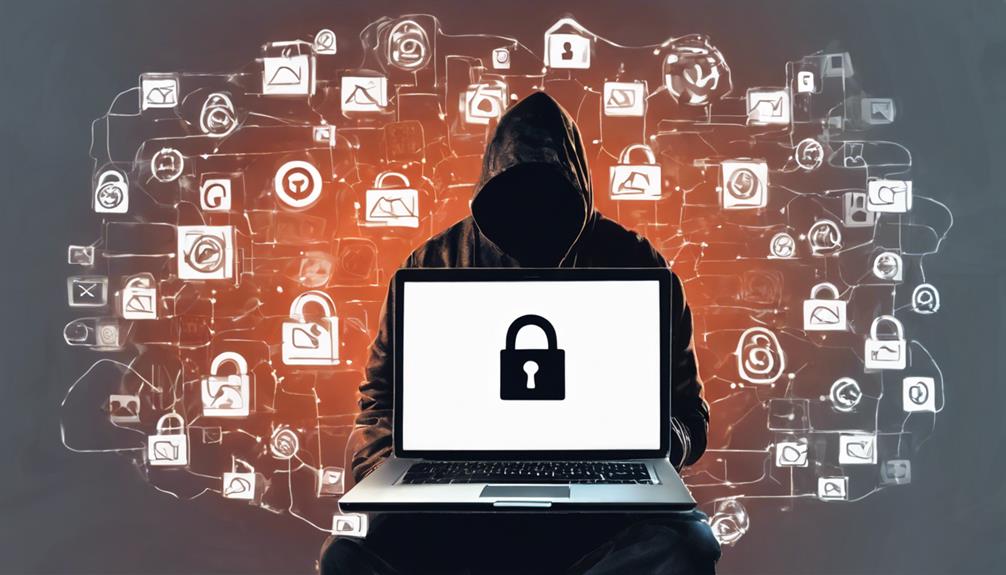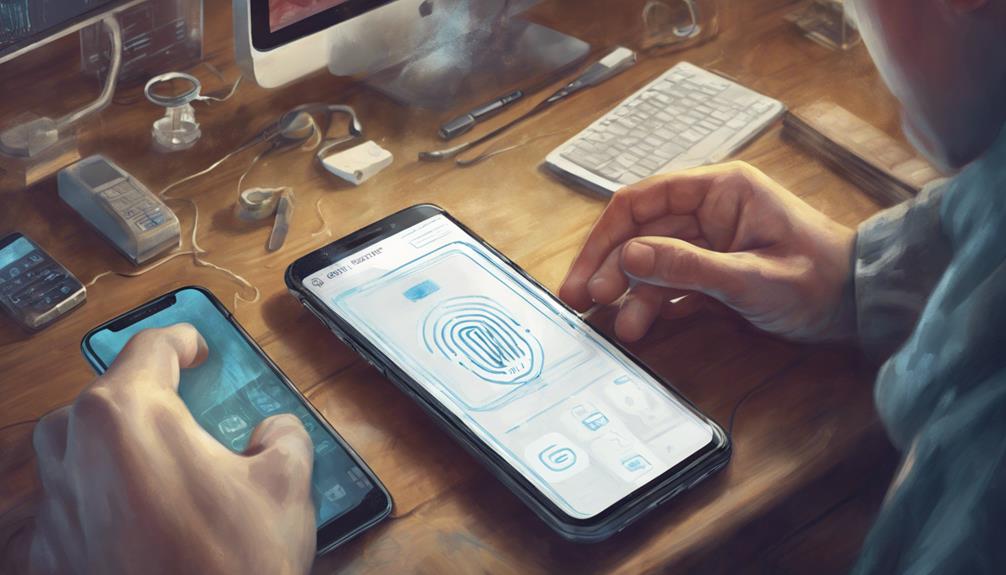Emails are not entirely safe from hackers due to vulnerabilities in email systems, which can lead to personal data interception and unauthorized access. Robust encryption protocols and heightened security measures are essential to enhance email safety. Common hacking methods include phishing attacks, weak passwords, malware installation, and data breaches. Signs of compromise include login issues, anomalies in sent messages, and suspicious activities. Immediate actions post-hack are vital to mitigate consequences such as identity theft and financial loss. Strengthening passwords, updating security software, and choosing secure email providers are key practices to enhance email security. Further details on email safety measures are available in the provided research.
Key Takeaways
- Emails are vulnerable to interception and unauthorized access.
- Lack of encryption poses security risks.
- Phishing attacks target email vulnerabilities.
- Strong passwords and security software mitigate risks.
- Select reputable email providers for added security.
Email Vulnerability Overview
Are emails truly secure from potential external threats and data breaches? Email security is a critical concern due to the inherent vulnerabilities in the system. One of the primary issues is the lack of encryption in email messages, which makes them susceptible to interception by hackers as they transit through various networks and servers. This vulnerability opens the door for unauthorized access to personal and sensitive data, putting individuals and organizations at risk of data breaches.
Moreover, phishing attacks further exacerbate the security risks associated with emails. These attacks target users by tricking them into divulging sensitive information, such as passwords or financial details, through deceptive means.
Additionally, once sensitive information is contained in emails, there is a risk of it being forwarded or saved without adequate security measures in place, making it an easy target for exploitation.
In essence, email security remains a significant concern in the digital age, requiring robust encryption protocols and heightened awareness to mitigate the risks of hacking and unauthorized access to sensitive data.
Common Email Hacking Methods

Email hacking methods encompass a variety of techniques used by cybercriminals to compromise email accounts and gain unauthorized access to sensitive information.
- Phishing Attacks: Phishing is a prevalent method, with 80% of hacking-related breaches involving deceptive emails aiming to trick recipients into revealing sensitive information.
- Weak Passwords: Weak passwords create vulnerabilities, as 65% of users reuse passwords across different accounts, making it easier for hackers to gain unauthorized access.
- Malware Installation: Cybercriminals often use email attachments or links to install malware on devices, with 92% of malware attacks originating from email sources.
- Data Breaches: Data breaches expose email accounts to hacking risks, with over 10 billion records compromised globally in 2020, providing cybercriminals with valuable information to target email accounts.
These methods, combined with Wi-Fi network vulnerabilities that allow hackers to intercept email communications, highlight the importance of implementing robust security measures to safeguard email accounts from unauthorized access and potential data breaches.
Signs of Email Compromise

Identifying signs of email compromise is vital in detecting potential security breaches and protecting sensitive information. Login issues, such as being unable to access your account despite entering correct credentials, are a red flag for email compromise.
Anomalies in sent messages, like emails you didn't send or recipients receiving spam emails from your account, indicate a hacked email. Additionally, if you notice strange social media posts that you didn't make, it could be linked to a compromised email.
Checking the IP address log for suspicious activity is important, as unauthorized access may leave behind traces in this log. Being vigilant and recognizing these signs promptly can help mitigate the risks associated with email compromise.
If any of these signs are noticed, it is imperative to take immediate action to secure your account and prevent further unauthorized access.
Immediate Actions After Email Hack

Recognizing the signs of email compromise prompts the immediate need to take decisive actions to secure the hacked account and prevent further unauthorized access.
To address an email hack effectively, follow these essential steps:
- Change Passwords: Swiftly update all passwords linked to the compromised email account to thwart any continued unauthorized entry.
- Enable Two-Factor Authentication: Implement this security measure on all relevant accounts to enhance protection against future breaches.
- Inform Contacts: Notify individuals in your contact list about the email hack to prevent them from falling prey to potential phishing attempts.
- Scan Devices: Conduct thorough malware scans on all devices to make sure that no malicious software has been installed by the hacker.
Consequences of Email Breach

Unauthorized access to personal information and potential exploitation by malicious actors are significant consequences of email breaches. When a breach occurs, sensitive data such as financial details can be exposed, leading to the risk of identity theft and fraud.
Hackers often leverage compromised email accounts to send phishing emails, attempting to deceive recipients into sharing more personal information or financial resources. Additionally, breached emails can result in social media hijacking, where hackers gain unauthorized access to individuals' online profiles, potentially exposing confidential information to the public.
The aftermath of an email breach goes beyond just personal consequences; it can also lead to reputational damage, financial loss, and even legal repercussions for both individuals and organizations. As such, it is essential to take immediate action to secure the compromised account, assess the extent of the breach, and enhance overall email security measures to prevent future incidents.
Strengthening email security post-breach is vital to mitigate the risks associated with unauthorized access to personal information and potential exploitation by cybercriminals.
Email Address Misuse by Hackers

Hackers can exploit compromised email addresses to perpetrate various malicious activities, such as phishing scams and identity theft. By gaining unauthorized access to personal information, hackers pose a significant risk to individuals' cybersecurity and privacy.
Safeguarding email addresses through strong security measures is vital to mitigate the potential misuse by cybercriminals and protect sensitive data from falling into the wrong hands.
Email Address Security
Email addresses are frequently targeted by cybercriminals for various malicious activities, posing risks to individuals' personal information and data security.
To enhance email address security and protect against hacker misuse, consider the following:
- Implement Strong Passwords: Using complex passwords with a mix of letters, numbers, and special characters can help deter unauthorized access to email accounts.
- Enable Two-Factor Authentication: Adding an extra layer of authentication beyond passwords can greatly enhance the security of email addresses.
- Beware of Phishing Attempts: Stay vigilant against suspicious emails requesting personal information or containing links to potentially harmful websites.
- Utilize Encryption: Encrypting email communications can safeguard sensitive data from interception by hackers during transmission.
Hacker Misuse Risks
What potential risks arise from the misuse of individuals' email addresses by cybercriminals?
When a hacker gets hold of your email account, they can use it to cover or protect their identity while sending potential phishing emails to trick recipients into revealing sensitive information. Additionally, hackers can use compromised email accounts to gain access to your email, potentially leading to security breaches and the misuse of personal information to prove or conduct identity theft. This misuse by hackers poses significant risks, including financial fraud, social engineering attacks, and unauthorized account takeovers.
To prevent all these risks, it is important to secure your email accounts, regularly update passwords, enable two-factor authentication, and be cautious of suspicious emails or links that could compromise your account. By taking these proactive measures, individuals can mitigate the dangers associated with hacker misuse of email addresses and protect themselves from cyber threats.
Email Security Best Practices

Implementing robust email security best practices is essential in safeguarding sensitive information from unauthorized access. To enhance email security effectively, consider the following measures:
- Use Strong Passwords: Create unique and complex passwords for your email accounts and enable two-factor authentication for an added layer of protection.
- Regularly Update Security Software: Keep your security software up to date to defend against evolving cyber threats and avoid falling victim to malicious attacks.
- Avoid Suspicious Links: Refrain from clicking on suspicious links or attachments in emails, as they could be phishing attempts aiming to compromise your email security.
- Choose Reputable Email Providers: Select a trusted email provider that offers robust security features and encryption tools to safeguard your emails from hacking attempts.
Email Phishing Prevention Tips

Phishing emails pose a significant threat to email security, with a majority of reported security incidents attributed to phishing scams.
To prevent falling victim to these malicious attacks, individuals should remain vigilant by checking for telltale signs such as misspelled URLs or suspicious email addresses.
Educating oneself and employees on common phishing tactics can enhance organizational email security and safeguard against data theft.
Phishing Email Awareness
Increasing awareness of deceptive emails, commonly known as phishing, is essential for safeguarding personal information and preventing cyber threats.
- Recognize Phishing Tactics:
Educate yourself on common phishing techniques such as fake links, urgent requests for personal information, and email spoofing.
- Verify Email Legitimacy:
Before clicking on any links or sharing personal details, double-check the sender's email address and look for any red flags indicating a fraudulent email.
- Report Suspicious Emails:
If you receive an email that seems suspicious or requests sensitive information, report it to the appropriate authorities or your organization's IT department.
- Protect Against Phishing Scams:
Stay informed about the latest phishing scams and take proactive measures to secure your personal information, such as updating passwords regularly and using multi-factor authentication.
Security Best Practices
To enhance email security and mitigate the risks of falling victim to phishing scams, it is imperative to establish robust security best practices that focus on proactive prevention measures.
One important step is to safeguard your email account password by using strong, unique passwords and enabling two-factor authentication. By doing so, you create an additional layer of protection against hackers trying to gain unauthorized access to your email accounts.
It is also essential to educate yourself and your team on common phishing tactics to recognize and avoid malicious emails. If you receive suspicious emails, refrain from clicking on any links or providing personal information. Instead, report these emails to the appropriate authorities to help prevent phishing attacks not only on yourself but also on others.
Additionally, regularly updating your security software and staying informed about the latest phishing trends are essential practices to safeguard your email accounts from potential security breaches.
Strengthening Email Passwords

Boosting the strength of email passwords is essential in safeguarding personal and sensitive information from unauthorized access. To enhance the security of your email accounts, consider the following recommendations:
- Use a mix of characters: Incorporate letters (both uppercase and lowercase), numbers, and symbols in your passwords to make them harder to crack.
- Change passwords regularly: Updating your passwords every 6 months can help prevent unauthorized individuals from gaining access to your emails.
- Utilize password managers: These tools can securely store and generate complex passwords, reducing the risk of using easily guessable ones.
- Implement multi-factor authentication: Adding an extra layer of security beyond passwords, such as through SMS codes or biometric verification, can greatly enhance the protection of your email accounts.
Selecting Secure Email Providers

Secure email providers play an essential role in safeguarding sensitive information by offering robust end-to-end encryption to protect messages from hackers. These providers go beyond basic security measures by incorporating features such as two-factor authentication to further enhance data protection.
When selecting a secure email provider, it is vital to prioritize user privacy and opt for services with a solid reputation for maintaining the confidentiality of user information. By choosing a reputable secure email provider, individuals can greatly reduce the risk of hacking and unauthorized access to their emails.
Additionally, reputable providers often implement strict data protection measures to safeguard user information from potential breaches. In today's digital age, where cyber threats are prevalent, opting for a secure email provider with strong encryption and a focus on user privacy is paramount in ensuring the confidentiality and security of sensitive communications.
Frequently Asked Questions
Can I Tell if My Email Has Been Hacked?
Determining if your email has been hacked involves monitoring for signs like login issues and unusual account activity. Check for suspicious IP addresses in your login history. Promptly respond to any indications of unauthorized access to safeguard your information.
What Happens if a Scammer Has Your Email Address?
If a scammer obtains your email address, they can engage in phishing attempts, spam campaigns, distribute malware, commit identity theft, sell your information on the Dark Web, and gain unauthorized access to your accounts, potentially compromising sensitive data.
Is It Safe to Give Someone Your Email Address?
In the vast digital landscape, sharing your email address is akin to handing over a key. While generally safe with reputable sources, exercising caution and considering secondary addresses for less secure platforms can enhance security measures.
How to Secure Your Mail?
To secure your email, use strong passwords, enable two-factor authentication, avoid public Wi-Fi for access, be cautious of email attachments/links, and choose a reputable provider with robust security measures. These steps enhance protection against potential hacking threats.
Conclusion
In summary, safeguarding emails from hackers is vital to protect sensitive information.
Just as a sturdy lock secures a valuable treasure, implementing strong security measures can fortify email defenses.
By following best practices, being vigilant against phishing attempts, and choosing secure email providers, individuals can reduce the risk of falling victim to email breaches.
Stay informed and proactive to guarantee the safety of your digital communication.









